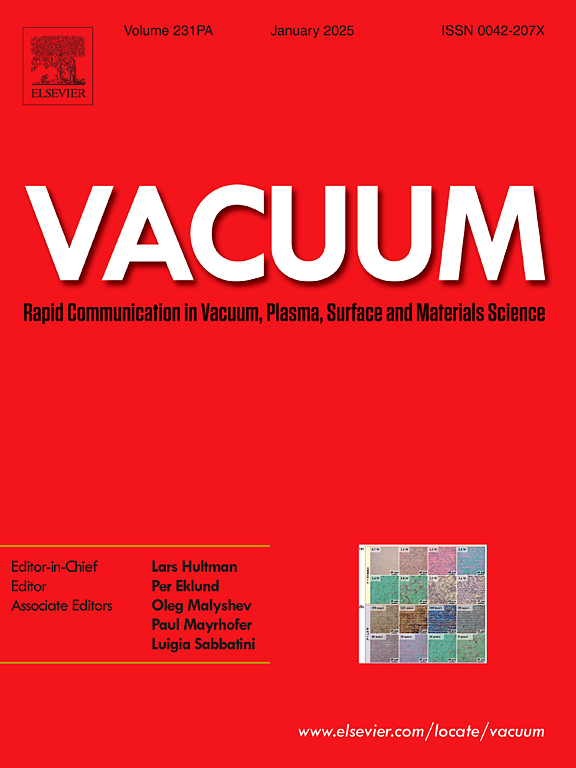Microstructure and surface monitoring of ECG signals for CrTiN-Ni coatings as dry bioelectrodes
IF 3.8
2区 材料科学
Q2 MATERIALS SCIENCE, MULTIDISCIPLINARY
引用次数: 0
Abstract
The CrTiN-Ni coatings were fabricated using unbalanced magnetron sputtering. These coatings primarily consist of CrN and TiN crystalline phases, with a relatively high Ni content ranging from 52.4 at.% to 64.0 at.%. The coatings exhibit relatively low contact impedance with a Ni content of 58.9–61.0 at.%. The noise impedance (Rn) of the CrTiN-Ni coating dry electrodes ranges from 1.11–1.90 × 106 Ω at a frequency of 1Hz, which is lower than that of the Ag/AgCl wet electrode (2.58 × 106 Ω). In the static testing of electrocardiogram (ECG) signals, the signal power of CrTiN-Ni coated dry electrodes was measured to be 1.1 × 10−3 to 1.3 × 10−3 W, which is approximately one order of magnitude higher than that of commercial wet electrodes (7.2× 10−4 W). In dynamic measurements, the signal power of all coating dry electrodes consistently exceeded that of commercial wet electrode. Additionally, the coated dry electrodes exhibited a relatively high signal-to-noise ratio (SNR), ranging from 56.7 to 65.1 dB, which is comparable to that of commercial wet electrodes (63.3 dB). This suggests that coated dry electrodes have considerable potential for use as dry bioelectrodes in practice.
CrTiN-Ni涂层干生物电极的微结构及表面监测
采用非平衡磁控溅射法制备了CrTiN-Ni涂层。这些涂层主要由CrN和TiN晶相组成,Ni含量相对较高,可达52.4 at。%至64.0%。镀层具有较低的接触阻抗,Ni含量为58.9 ~ 61.0 at.%。CrTiN-Ni涂层干电极在1Hz频率下的噪声阻抗(Rn)为1.11 ~ 1.90 × 106 Ω,低于Ag/AgCl湿电极的噪声阻抗(2.58 × 106 Ω)。在心电图(ECG)信号的静态测试中,测量到CrTiN-Ni涂层干电极的信号功率为1.1 × 10−3至1.3 × 10−3 W,比商用湿电极的信号功率(7.2× 10−4 W)高出约一个数量级。在动态测量中,所有涂层干电极的信号功率始终超过商用湿电极。此外,涂层干电极表现出相对较高的信噪比(SNR),范围为56.7至65.1 dB,与商用湿电极(63.3 dB)相当。这表明涂层干电极在实践中作为干生物电极具有相当大的潜力。
本文章由计算机程序翻译,如有差异,请以英文原文为准。
求助全文
约1分钟内获得全文
求助全文
来源期刊

Vacuum
工程技术-材料科学:综合
CiteScore
6.80
自引率
17.50%
发文量
0
审稿时长
34 days
期刊介绍:
Vacuum is an international rapid publications journal with a focus on short communication. All papers are peer-reviewed, with the review process for short communication geared towards very fast turnaround times. The journal also published full research papers, thematic issues and selected papers from leading conferences.
A report in Vacuum should represent a major advance in an area that involves a controlled environment at pressures of one atmosphere or below.
The scope of the journal includes:
1. Vacuum; original developments in vacuum pumping and instrumentation, vacuum measurement, vacuum gas dynamics, gas-surface interactions, surface treatment for UHV applications and low outgassing, vacuum melting, sintering, and vacuum metrology. Technology and solutions for large-scale facilities (e.g., particle accelerators and fusion devices). New instrumentation ( e.g., detectors and electron microscopes).
2. Plasma science; advances in PVD, CVD, plasma-assisted CVD, ion sources, deposition processes and analysis.
3. Surface science; surface engineering, surface chemistry, surface analysis, crystal growth, ion-surface interactions and etching, nanometer-scale processing, surface modification.
4. Materials science; novel functional or structural materials. Metals, ceramics, and polymers. Experiments, simulations, and modelling for understanding structure-property relationships. Thin films and coatings. Nanostructures and ion implantation.
 求助内容:
求助内容: 应助结果提醒方式:
应助结果提醒方式:


